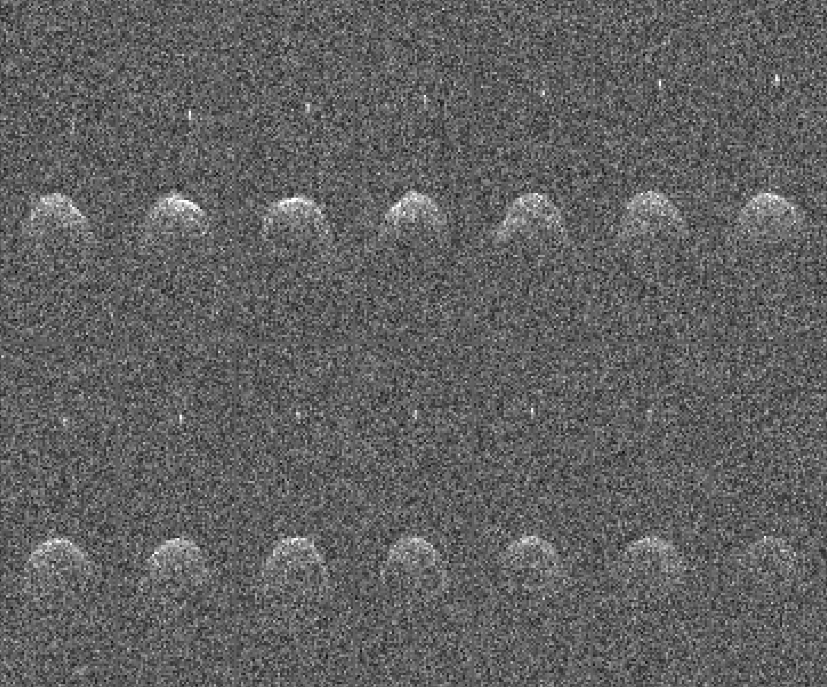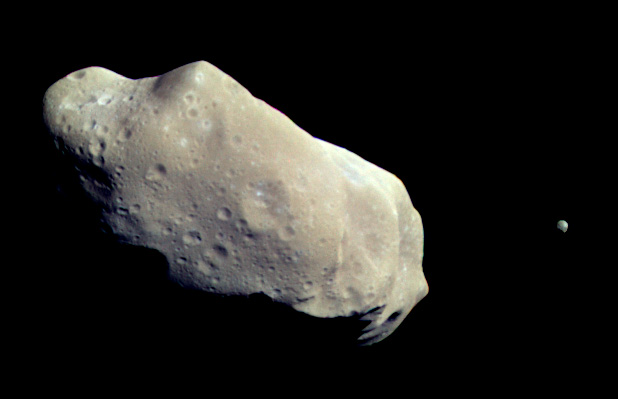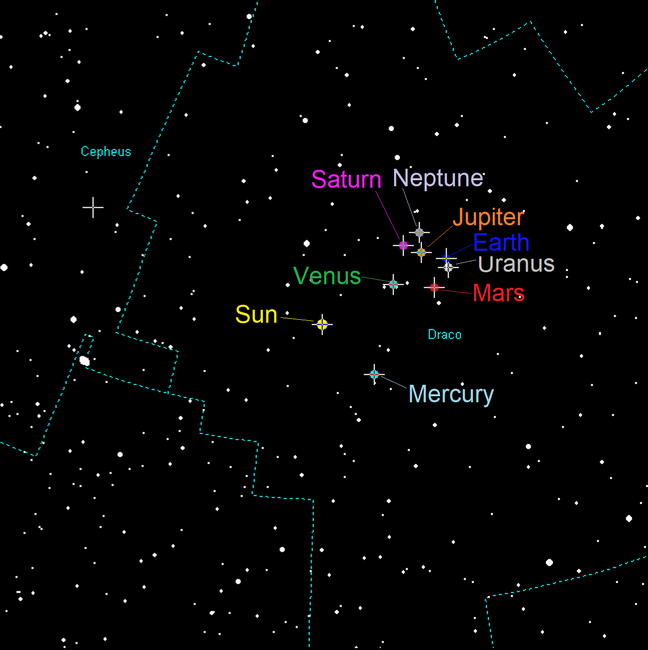|
Dimorphos
(65803) Didymos I Dimorphos ( provisional designation S/2003 (65803) 1) is a minor-planet moon of the near-Earth asteroid 65803 Didymos, with which it forms a binary system. It has a diameter of and has been characterised as a low-density rubble pile. Discovered in 2003 at the Ondřejov Observatory, Dimorphos was the target of the Double Asteroid Redirection Test (DART), a NASA space mission that deliberately collided a spacecraft with the moon in September 2022 to alter its orbit around Didymos. The ESA mission ''Hera'' is planned to arrive at the Didymos system in 2026 to further study the effects of the collision on the moon. Nomenclature The Working Group for Small Bodies Nomenclature of the International Astronomical Union (IAU) gave the satellite its official name on 23 June 2020. The name ''Dimorphos'' is derived from a Greek word () meaning 'having two forms'. The justification for the new name reads: "As the target of the DART and ''Hera'' space missions, ... [...More Info...] [...Related Items...] OR: [Wikipedia] [Google] [Baidu] |
Double Asteroid Redirection Test
Double Asteroid Redirection Test (DART) is a NASA space mission aimed at testing a method of planetary defense against near-Earth objects (NEOs). It was designed to assess how much a spacecraft impact deflects an asteroid through its transfer of momentum when hitting the asteroid head-on. The asteroid selected for the test poses no actual threat to Earth and was selected for the convenience of the test. The probe was launched from Earth on 24 November 2021, and on 26 September 2022 intentionally crashed into Dimorphos, the minor-planet moon of the asteroid Didymos. On 11 October, NASA declared DART a success, confirming it had shortened Dimorphos' orbital period around Didymos by about 32 minutes, surpassing the pre-defined success threshold of 73 seconds. DART is a joint project between NASA and the Johns Hopkins Applied Physics Laboratory (APL). The project was funded through NASA's Planetary Defense Coordination Office, managed by NASA's Planetary Missions Program Off ... [...More Info...] [...Related Items...] OR: [Wikipedia] [Google] [Baidu] |
65803 Didymos
65803 Didymos (provisional designation ) is a sub-kilometer asteroid and binary system that is classified as a potentially hazardous asteroid and near-Earth object of the Apollo group. The asteroid was discovered in 1996 by the Spacewatch survey at Kitt Peak, and its small 160-meter minor-planet moon, named Dimorphos, was discovered in 2003. Due to its binary nature, the asteroid was then named ''Didymos'', the Greek word for 'twin'. Didymos's moon, Dimorphos, was the target of the DART mission to test the viability of asteroid impact avoidance by collision with a spacecraft, while the impact was witnessed by LICIACube, a flyby CubeSat component of the mission. Discovery Didymos was discovered on 11 April 1996 by the University of Arizona Steward Observatory's, and Lunar and Planetary Laboratory's, Spacewatch survey using its 0.9-meter telescope at Kitt Peak National Observatory in Arizona, United States. The binary nature of the asteroid was discovered by others; suspic ... [...More Info...] [...Related Items...] OR: [Wikipedia] [Google] [Baidu] |
Binary Asteroid
A binary asteroid is a system of two asteroid An asteroid is a minor planet of the Solar System#Inner solar system, inner Solar System. Sizes and shapes of asteroids vary significantly, ranging from 1-meter rocks to a dwarf planet almost 1000 km in diameter; they are rocky, metallic o ...s orbiting their common barycenter. The binary nature of 243 Ida was discovered when the Galileo spacecraft flew by the asteroid in 1993. Since then numerous binary asteroids and several triple asteroids have been detected. The mass ratio of the two components – called the "primary" and "secondary" of a binary system – is an important characteristic. Most binary asteroids have a large mass ratio, i.e. a relatively small satellite in orbit around the main component. Systems with a small minor-planet moon – also called "companion" or simply "satellite" – include 87 Sylvia, 107 Camilla, 45 Eugenia, 121 Hermione, 130 Elektra, 22 Kalliope, ... [...More Info...] [...Related Items...] OR: [Wikipedia] [Google] [Baidu] |
Near-Earth Object
A near-Earth object (NEO) is any small Solar System body whose orbit brings it into proximity with Earth. By convention, a Solar System body is a NEO if its closest approach to the Sun (perihelion) is less than 1.3 astronomical units (AU). If a NEO's orbit crosses the Earth's orbit, and the object is larger than across, it is considered a potentially hazardous object (PHO). Most known PHOs and NEOs are asteroids, but a small fraction are comets. There are over 30,503 known near-Earth asteroids (NEAs) and over a hundred known short-period near-Earth comets (NECs). A number of solar-orbiting meteoroids were large enough to be tracked in space before striking the Earth. It is now widely accepted that collisions in the past have had a significant role in shaping the geological and biological history of the Earth. Asteroids as small as in diameter can cause significant damage to the local environment and human populations. Larger asteroids penetrate the atmosphere to the s ... [...More Info...] [...Related Items...] OR: [Wikipedia] [Google] [Baidu] |
Minor-planet Moon
A minor-planet moon is an astronomical object that orbits a minor planet as its natural satellite. , there are 457 minor planets known or suspected to have moons. Discoveries of minor-planet moons (and binary objects, in general) are important because the determination of their orbits provides estimates on the mass and density of the primary, allowing insights into their physical properties that are generally not otherwise accessible. Several of the moons are quite large compared to their primaries: 90 Antiope, Mors–Somnus and Sila–Nunam (95%), Patroclus–Menoetius, Altjira and Lempo–Hiisi (90%, with Lempo–Paha at 50%). The largest known minor-planet moon in ''absolute'' size is Pluto's largest moon Charon, which itself has about half the diameter of Pluto. The first modern era mention of the possibility of an asteroid satellite was in connection with an occultation of the bright star Gamma Ceti by the asteroid 6 Hebe in 1977. The obse ... [...More Info...] [...Related Items...] OR: [Wikipedia] [Google] [Baidu] |
Jet Propulsion Laboratory
The Jet Propulsion Laboratory (JPL) is a federally funded research and development center and NASA field center in the City of La Cañada Flintridge, California, United States. Founded in the 1930s by Caltech researchers, JPL is owned by NASA and managed by the nearby California Institute of Technology (Caltech). The laboratory's primary function is the construction and operation of planetary robotic spacecraft, though it also conducts Earth-orbit and astronomy missions. It is also responsible for operating the NASA Deep Space Network. Among the laboratory's major active projects are the Mars 2020 mission, which includes the '' Perseverance'' rover and the '' Ingenuity'' Mars helicopter; the Mars Science Laboratory mission, including the '' Curiosity'' rover; the InSight lander (''Interior Exploration using Seismic Investigations, Geodesy and Heat Transport''); the ''Mars Reconnaissance Orbiter''; the '' Juno'' spacecraft orbiting Jupiter; the '' SMAP'' satellite for earth ... [...More Info...] [...Related Items...] OR: [Wikipedia] [Google] [Baidu] |
Ecliptic Coordinates
The ecliptic coordinate system is a celestial coordinate system commonly used for representing the apparent positions, orbits, and pole orientations of Solar System objects. Because most planets (except Mercury) and many small Solar System bodies have orbits with only slight inclinations to the ecliptic, using it as the fundamental plane is convenient. The system's origin can be the center of either the Sun or Earth, its primary direction is towards the vernal (March) equinox, and it has a right-hand convention. It may be implemented in spherical or rectangular coordinates. Primary direction The celestial equator and the ecliptic are slowly moving due to perturbing forces on the Earth, therefore the orientation of the primary direction, their intersection at the Northern Hemisphere vernal equinox, is not quite fixed. A slow motion of Earth's axis, precession, causes a slow, continuous turning of the coordinate system westward about the poles of the ecliptic, comple ... [...More Info...] [...Related Items...] OR: [Wikipedia] [Google] [Baidu] |
Provisional Designation
Provisional designation in astronomy is the naming convention applied to astronomical objects immediately following their discovery. The provisional designation is usually superseded by a permanent designation once a reliable orbit has been calculated. Approximately 47% of the more than 1,100,000 known minor planets remain provisionally designated, as hundreds of thousands have been discovered in the last two decades. __TOC__ Minor planets The current system of provisional designation of minor planets (asteroids, centaurs and trans-Neptunian objects) has been in place since 1925. It superseded several previous conventions, each of which was in turn rendered obsolete by the increasing numbers of minor planet discoveries. A modern or new-style provisional designation consists of the year of discovery, followed by two letters and, possibly, a suffixed number. New-style provisional designation For example, the provisional designation stands for the 3910th body identified du ... [...More Info...] [...Related Items...] OR: [Wikipedia] [Google] [Baidu] |
S-type Asteroid
S-type asteroids are asteroids with a spectral type that is indicative of a siliceous (i.e. stony) mineralogical composition, hence the name. They have relatively high density. Approximately 17% of asteroids are of this type, making it the second most common after the carbonaceous C-type. Characteristics S-type asteroids, with an astronomical albedo of typically 0.20, are moderately bright and consist mainly of iron- and magnesium- silicates. They are dominant in the inner part of the asteroid belt within 2.2 AU, common in the central belt within about 3 AU, but become rare farther out. The largest are 3 Juno (about 240–250 km across) and 15 Eunomia (230 km), with other large S-types being 29 Amphitrite, 532 Herculina and 7 Iris. These largest S-types are visible in 10x50 binoculars at most oppositions; the brightest, 7 Iris, can occasionally become brighter than +7.0, which is a higher magnitude than any asteroid except the unusually reflective 4 Vesta ... [...More Info...] [...Related Items...] OR: [Wikipedia] [Google] [Baidu] |
Synchronous Rotation
Tidal locking between a pair of co-orbiting astronomical bodies occurs when one of the objects reaches a state where there is no longer any net change in its rotation rate over the course of a complete orbit. In the case where a tidally locked body possesses synchronous rotation, the object takes just as long to rotate around its own axis as it does to revolve around its partner. For example, the same side of the Moon always faces the Earth, although there is some variability because the Moon's orbit is not perfectly circular. Usually, only the satellite is tidally locked to the larger body. However, if both the difference in mass between the two bodies and the distance between them are relatively small, each may be tidally locked to the other; this is the case for Pluto and Charon. Alternative names for the tidal locking process are gravitational locking, captured rotation, and spin–orbit locking. The effect arises between two bodies when their gravitational interaction ... [...More Info...] [...Related Items...] OR: [Wikipedia] [Google] [Baidu] |
Angle
In Euclidean geometry, an angle is the figure formed by two rays, called the '' sides'' of the angle, sharing a common endpoint, called the '' vertex'' of the angle. Angles formed by two rays lie in the plane that contains the rays. Angles are also formed by the intersection of two planes. These are called dihedral angles. Two intersecting curves may also define an angle, which is the angle of the rays lying tangent to the respective curves at their point of intersection. ''Angle'' is also used to designate the measure of an angle or of a rotation. This measure is the ratio of the length of a circular arc to its radius. In the case of a geometric angle, the arc is centered at the vertex and delimited by the sides. In the case of a rotation, the arc is centered at the center of the rotation and delimited by any other point and its image by the rotation. History and etymology The word ''angle'' comes from the Latin word ''angulus'', meaning "corner"; cognate words are ... [...More Info...] [...Related Items...] OR: [Wikipedia] [Google] [Baidu] |
Ecliptic North Pole
An orbital pole is either point at the ends of an imaginary line segment that runs through the center of an orbit (of a revolving body like a planet, moon or satellite) and is perpendicular to the orbital plane. Projected onto the celestial sphere, orbital poles are similar in concept to celestial poles, but are based on the body's orbit instead of its equator. The north orbital pole of a revolving body is defined by the right-hand rule. If the fingers of the right hand are curved along the direction of orbital motion, with the thumb extended and oriented to be parallel to the orbital axis, then the direction the thumb points is defined to be the orbital north. The poles of Earth's orbit are referred to as the ecliptic poles. For the remaining planets, the orbital pole in ecliptic coordinates is given by the longitude of the ascending node (☊) and inclination (''i''): ''l'' = ☊ - 90°, ''b'' = 90° - ''i''. In the following table, the planetary orbit poles are g ... [...More Info...] [...Related Items...] OR: [Wikipedia] [Google] [Baidu] |








.jpg)

